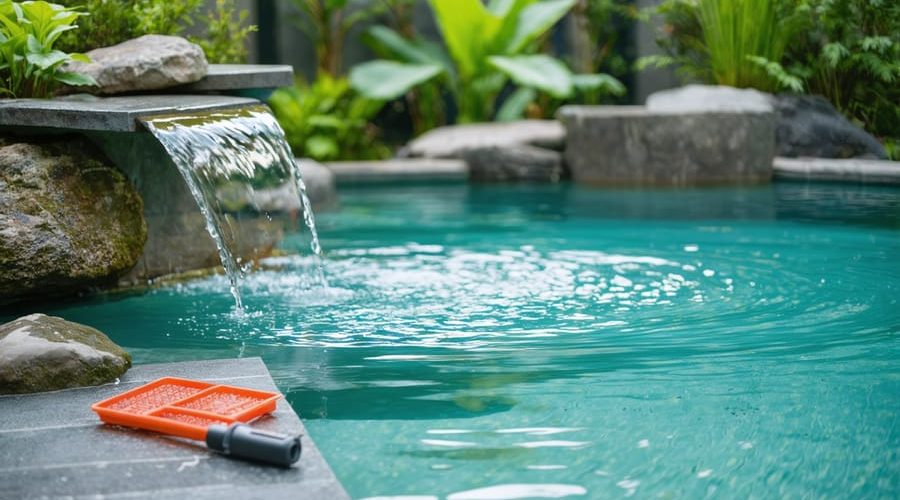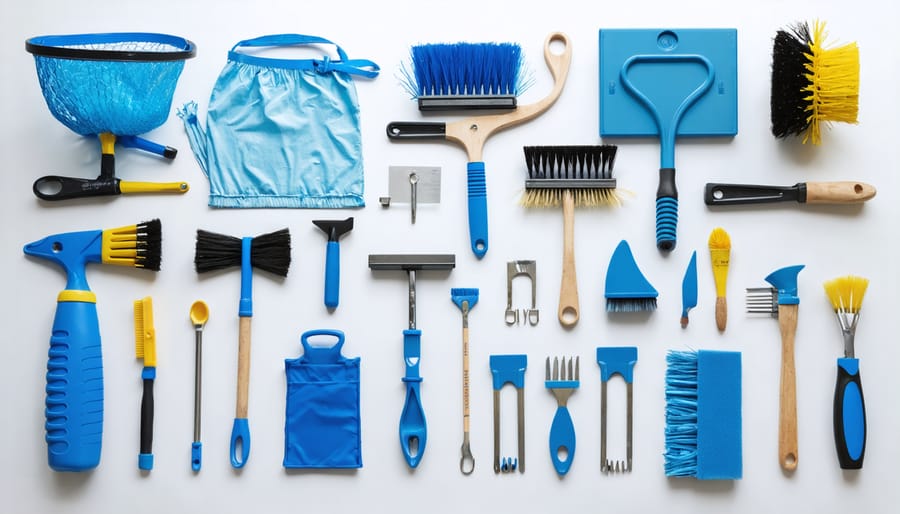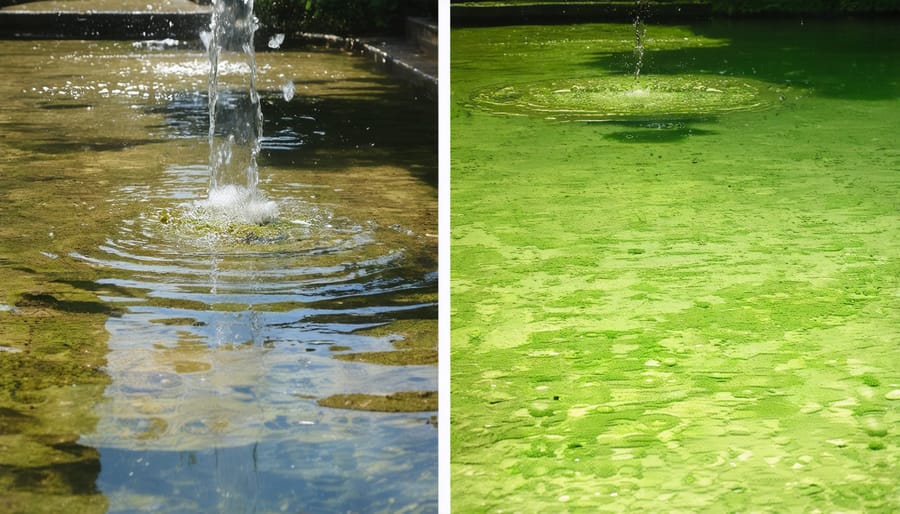
Keep Your Water Feature Crystal Clear with These Expert Maintenance Tips
Transform your water feature from a maintenance headache into a stunning focal point with proper care and attention. Whether you have a small fountain or an elaborate pond, regular maintenance ensures crystal-clear water, healthy aquatic life, and optimal performance year-round.
Regular water feature maintenance isn’t just about aesthetics – it’s crucial for protecting your investment and maintaining a healthy ecosystem. From preventing algae blooms to maintaining proper water chemistry, each maintenance task plays a vital role in your water feature’s longevity and beauty.
This comprehensive guide breaks down essential maintenance tasks into manageable steps, helping you create a sustainable maintenance routine that fits your schedule and skill level. Learn proven techniques for keeping pumps running efficiently, managing aquatic plants, and troubleshooting common issues before they become major problems.
With the right knowledge and tools, maintaining your water feature can become a rewarding part of your outdoor routine rather than a daunting chore. Let’s dive into the essential practices that will keep your water feature running beautifully throughout every season.

Essential Water Feature Maintenance Tools
Basic Cleaning Equipment
Keeping your water feature sparkling clean starts with having the right tools on hand. A long-handled pond net is essential for scooping out fallen leaves, debris, and any unwanted materials that find their way into your water feature. Look for nets with fine mesh to catch even small particles, and choose a handle length that lets you comfortably reach all areas of your feature.
A pond skimmer is your best friend for daily maintenance, helping you remove floating debris before it sinks and causes problems. These handy tools work like a pool skimmer, allowing you to quickly sweep across the water’s surface to maintain clarity.
For the sides and bottom of your water feature, a good brush set is invaluable. Soft-bristled brushes help remove algae and buildup without damaging the surface material. Consider having brushes in different sizes – a large one for general cleaning and a smaller brush for detailed work around decorative elements and corners.
When it comes to thorough cleaning, a pond vacuum is worth the investment. These specialized vacuum cleaners are designed to remove settled debris and sludge from the bottom of your water feature without completely draining it. Most models come with different attachments to reach tight spots and handle various types of debris.
Remember to keep your cleaning tools clean and stored properly between uses to prevent cross-contamination and extend their lifespan.
Water Testing Tools
Regular water testing is essential for maintaining a healthy and balanced water feature. The good news is that there are several user-friendly tools available to help you monitor your water quality effectively. Let’s explore the must-have testing equipment for your maintenance toolkit.
pH meters are your first line of defense in water quality management. These handy devices give you instant readings of your water’s acidity or alkalinity levels. Look for digital pH meters with automatic temperature compensation for the most accurate results. While professional models can be expensive, there are many affordable options perfect for home use.
Test strips are another popular choice for water testing. These multi-parameter strips can check for various elements, including pH, chlorine, and alkalinity, all in one go. They’re incredibly easy to use – just dip, wait, and compare the colors to the provided chart. While not as precise as electronic meters, they’re perfect for regular monitoring and quite budget-friendly.
For more comprehensive monitoring, consider investing in water flow meters and electronic water quality monitors. These tools can track multiple parameters simultaneously and even alert you when something’s amiss. Many modern versions connect to smartphone apps, making it easier than ever to keep tabs on your water feature’s health.
Remember to keep your testing tools clean and properly calibrated for accurate readings. Store them in a cool, dry place, and replace test strips before their expiration date to ensure reliable results.
Seasonal Maintenance Tasks
Spring Cleaning and Setup
When spring arrives, it’s time to wake your water feature from its winter slumber. Start by removing any protective covers and clearing away debris that accumulated during the cold months. Grab a pair of gloves and remove leaves, twigs, and other organic matter from both the water and surrounding areas.
Next, thoroughly inspect all components for winter damage. Check pumps, filters, and plumbing for cracks or wear. If you stored your pump indoors, now’s the time to reinstall it. Before plugging it in, clean the impeller and ensure it spins freely.
Give your water feature a good cleaning by draining the water and gently scrubbing surfaces with a soft brush. Avoid using harsh chemicals – a mixture of water and white vinegar works well for removing mineral deposits. Pay special attention to removing algae buildup that may have formed during the winter months.
Once cleaned, refill your feature with fresh water. If you have a pond with fish, remember to treat the water with a dechlorinator. Check water levels and adjust any settings on your pump to achieve the desired flow rate.
Finally, trim back any surrounding plants and add seasonal aquatic plants if desired. Monitor the water feature for the first few days to ensure everything is running smoothly. Regular maintenance throughout spring will help prevent issues later in the season.
Summer Care Routines
Summer brings unique challenges for water feature maintenance, with warm temperatures creating the perfect environment for algae growth. To keep your water feature looking its best while following water-efficient maintenance practices, start by checking water levels daily, as evaporation increases during hot weather.
Combat algae growth by adding beneficial bacteria and maintaining proper filtration. A UV clarifier can work wonders in preventing green water, while floating plants provide natural shade and help balance the ecosystem. Aim to keep about 60% of your water surface covered with plants during peak summer months.
Regular skimming of debris becomes more important in summer, as decomposing organic matter feeds algae growth. Consider installing a fine mesh net over smaller features to catch leaves and debris before they sink.
Monitor water quality weekly using simple test strips. Keep pH levels between 6.8 and 7.2 for optimal conditions. If you notice the water becoming cloudy, perform a partial water change of about 15-20% rather than a complete refresh to maintain beneficial bacteria colonies.
For fountains and smaller features, clean pump filters every two weeks to ensure proper circulation. Remember to top up water levels in the morning or evening to reduce unnecessary evaporation and maintain consistent water chemistry.
Fall and Winter Preparation
As temperatures drop, it’s crucial to prepare your water feature for the colder months ahead. Start by removing fallen leaves and debris before they can sink and decompose. A pond net stretched across the surface can catch falling leaves and make cleanup easier throughout autumn.
If you live in an area where temperatures drop below freezing, you’ll need to decide whether to keep your water feature running or shut it down for winter. For smaller features, you might choose to drain and store them indoors. For larger ponds, maintaining water flow can actually help prevent freezing and protect fish.
If keeping your feature running, install a de-icer to maintain a small opening in the ice for gas exchange. Remove and clean pumps, storing them in a bucket of water in a frost-free location to prevent seals from drying out. Trim back any aquatic plants and move tropical varieties indoors.
For complete winterization, drain the system entirely, clean all components, and store them properly. Remove or drain external plumbing to prevent freeze damage. If you have fish, ensure the pond depth provides adequate unfrozen water below the ice layer.
Remember to check your feature periodically throughout winter, especially after storms or extreme weather events. This helps catch any issues early and ensures your water feature will be ready to shine again in spring.
Common Problems and Solutions
Algae Control
Algae can turn your beautiful water feature into a green, murky mess, but don’t worry – there are several effective ways to keep these unwanted guests at bay. The key to algae control is prevention and regular maintenance.
Start by ensuring your water feature has proper circulation. Moving water makes it harder for algae to establish itself. Adding a pump or fountain head can significantly improve water movement. Consider installing UV clarifiers, which use ultraviolet light to kill algae spores before they can multiply.
Natural solutions are often the most sustainable approach. Adding aquatic plants like water lilies and floating plants helps shade the water, reducing sunlight that algae needs to grow. Beneficial bacteria supplements can also help by competing with algae for nutrients.
For existing algae problems, start with manual removal using a net or rake. Then, maintain proper water chemistry by testing regularly and using appropriate treatments. Barley straw or barley extract acts as a natural algaecide, slowly releasing compounds that inhibit algae growth.
Remember to avoid overfeeding fish if you have them, as excess nutrients from uneaten food contribute to algae growth. Regular water changes of about 10-15% every few weeks help maintain water quality and remove accumulated nutrients that feed algae.
Finally, position your water feature to receive partial shade during the hottest parts of the day, as direct sunlight promotes algae growth.


Pump and Filter Maintenance
Regular maintenance of your pump and filtration system is crucial for keeping your water feature running smoothly. Start by checking your pump monthly to ensure it’s free from debris and operating at full capacity. You can easily monitor pump performance using flow meters, which help detect issues before they become serious problems.
Clean your pump’s impeller every few months by gently removing it and brushing away any built-up grime or calcium deposits. If you notice unusual noises or reduced water flow, this is often a sign that your pump needs attention. Don’t forget to check the pump’s intake screen regularly and remove any leaves or debris that might cause blockages.
For filtration systems, establish a routine cleaning schedule based on your water feature’s size and location. Mechanical filters should be cleaned every 2-4 weeks, while biological filters typically need attention every 3-6 months. When cleaning, use pond water rather than tap water to preserve beneficial bacteria.
During winter, if you live in a cold climate, either remove the pump entirely or ensure it’s protected from freezing. Store removed pumps in a bucket of water to prevent seals from drying out. Remember to inspect all electrical connections periodically for signs of wear or damage, and replace any worn parts promptly to prevent system failure.
Water Quality Management
Maintaining pristine water quality is essential for any water feature’s health and visual appeal. Regular testing is your first line of defense – aim to check water parameters weekly using a reliable test kit. The key factors to monitor are pH levels (ideally between 7.0-7.4), alkalinity, and chlorine content.
To maintain crystal-clear water, use a combination of biological and mechanical filtration. Beneficial bacteria help break down organic waste, while mechanical filters remove debris. Adding the right amount of water treatments and algaecides can prevent green water and algae buildup. Remember to conserve water by only replacing what’s necessary – typically about 10-15% monthly.
When adding new water, always use a dechlorinator to neutralize harmful chemicals. If you notice cloudy water, first check your filter system and clean it if necessary. For stubborn clarity issues, UV clarifiers can work wonders by eliminating floating algae and harmful bacteria.
Keep an eye on water levels, especially during hot weather, and top up as needed. Adding aquatic plants can naturally help maintain water quality by absorbing excess nutrients and providing shade. Remember, consistency is key – regular maintenance prevents major problems and keeps your water feature looking its best year-round.
Maintaining your water feature doesn’t have to be a daunting task. By following the essential maintenance practices we’ve discussed, you can keep your water feature looking beautiful and functioning properly all year round. Remember that regular cleaning, water quality monitoring, and equipment checks are the foundation of good maintenance.
Make it a habit to check your water levels weekly, remove debris as it appears, and inspect your pumps and filters monthly. Seasonal maintenance tasks, like deep cleaning in spring and winterizing in fall, help prevent major issues and extend your water feature’s lifespan.
Don’t wait for problems to develop before taking action. Prevention is always easier and less expensive than repairs. Keep a maintenance calendar and set reminders for important tasks throughout the year. Stock up on essential supplies and tools so you’re always prepared to handle routine maintenance.
Your water feature is an investment in your home’s beauty and your outdoor enjoyment. Taking care of it regularly will reward you with the soothing sounds of flowing water, healthy aquatic plants, and a stunning focal point in your landscape. Remember, even small maintenance tasks make a big difference when done consistently.
By staying proactive and attentive to your water feature’s needs, you’ll spend less time troubleshooting and more time enjoying your peaceful outdoor oasis. Happy maintaining!
